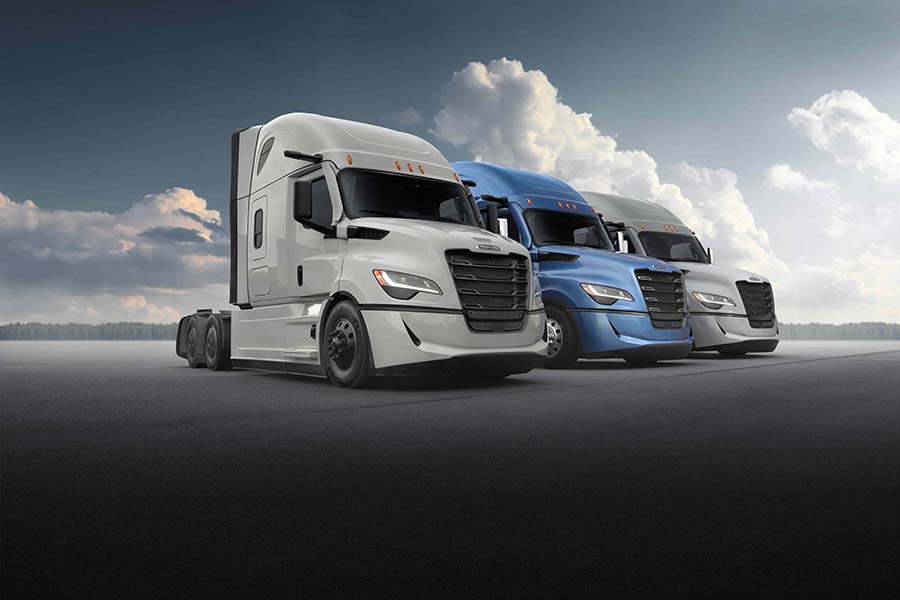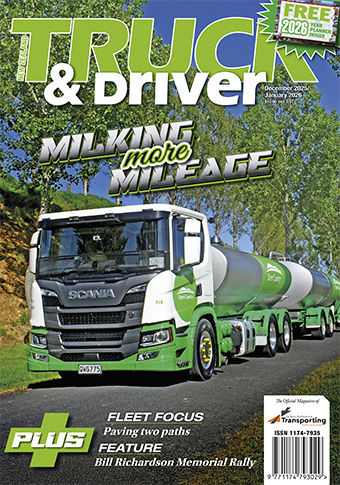Aeolus Truck & Driver News


High tech Gen-5 Cascadia unveiled
Aeolus Truck & Driver News
The fifth generation Freightliner Cascadia has been unveiled by Daimler Truck North America.
Production is timed to begin mid-2025 at manufacturing plants in Portland, Oregon and Saltillo, Mexico.
Development priorities for the new Cascadia focused on fuel efficiency and the continued introduction of advanced safety features and connectivity tools.
“Since its original introduction in 2007, our customers have purchased more than one million Freightliner Cascadias, making it the most driven Class 8 truck on North American roads,” says David Carson, senior vice president of sales and marketing, Daimler Truck North America.
...The fifth generation Freightliner Cascadia has been unveiled by Daimler Truck North America.
Production is timed to begin mid-2025 at manufacturing plants in Portland, Oregon and Saltillo, Mexico.
Development priorities for the new Cascadia focused on fuel efficiency and the continued introduction of advanced safety features and connectivity tools.
“Since its original introduction in 2007, our customers have purchased more than one million Freightliner Cascadias, making it the most driven Class 8 truck on North American roads,” says David Carson, senior vice president of sales and marketing, Daimler Truck North America.
The fifth generation Cascadia debuts expanded capabilities from the Detroit Assurance suite of safety systems. Notable updates include enhanced computing power and an upgraded camera, as well as four new short-range radar sensors and an improved long-range radar sensor.
Detroit’s Active Brake Assist 6 (ABA6) is now capable of adding automatic braking when detecting vehicles stopped at odd angles, vehicles in curves, stopped vehicles across multiple lanes, and recognising both moving – and now – stationary pedestrians.
In addition to its previous capabilities, Active Lane Assist 2 (ALA2) now features Lane Change Assist – which can help mitigate out-of-lane accidents by providing counter steering in case a truck attempts to enter an already occupied lane.
A component of ALA2 is Attentive Driver Protection. When Lane Keep Assist is on and active, this monitors driver attention through steering wheel input and can initiate a sequence that keeps the Cascadia centred in its lane, slows the vehicle to a stop and turns on the hazard lights if the driver is not responsive.
The updated Side Guard Assist 2 (SGA2) is now able to detect and warn drivers about objects on the driver side as well as the passenger side of the vehicle, from the cab to the end of the trailer.
New Cascadia is also equipped with all-new Intelligent Braking Control System (IBCS) which introduces brake-by-wire technology combined with backup pneumatics. The system employs wheel speed sensors and a chassis-mounted electronic control unit to help provide advanced deceleration control.
IBCS enables the introduction of Comfort Braking, which provides brake force distribution, lining wear control and performance monitoring. These features ensure smoother, more confident braking – especially in sudden stops – and help to elongate brake pad life through even wear.
Endurance Braking is a further feature of IBCS that seamlessly blends the engine retarder and service brakes when the foot pedal is applied, helping to further extend brake life.
An all-new electronic park brake enables Rollaway Mitigation, which is designed to automatically apply the parking brake when a driver leaves the seat or opens the door without setting the brake to help prevent costly rollaways and improve safety.
Another new technology is the Dual Stage Intelligent LED headlights, which offer increased durability and impact resistance. They are also engineered to melt away ice and eliminate condensation in minutes. With an improved beam pattern and auto high beam feature, they enhance visibility, safety and driver comfort.
The MirrorCam System previously introduced on Mercedes-Benz models can also be fitted to the new Cascadia.
Cameras mounted above the doors provide a wide field of view and are equipped with infrared technology and hydrophobic coatings to repel water and other contaminants. MirrorCam helps to improve visibility, especially at night and during inclement weather, and improve driver comfort by minimizing head and neck movement.
Efficiency gains are based on powertrain upgrades and improved aerodynamics and the Freightliner Cascadia has achieved fuel efficiency gains of more than 35% since the first generation was introduced.
Key aerodynamic improvements for the fifth generation include a new bonnet design, a redesigned A-pillar deflector, three-piece front wheel well closeouts, a hood-to-bumper seal, and new bumper air ducts that direct airflow around the underbody and tires to increase efficiency.
These changes yield an additional fuel economy benefit of 1.9%. A new (optional) Max Aero Bumper, brings even greater efficiency without sacrificing ground clearance, durability or serviceability.
Engine choices for the fifth generation are from the Detroit DD13 and DD15 line-ups, with ratings up to 505hp and 1,850 lb-ft of torque.
The Cummins X15 and X15N, the first natural gas engine designed specifically for heavy-duty and on-highway truck applications, will be available in 2025 and 2026, respectively, and are available with 400 to 605hp and 1,450 to 2,050 lb-ft of torque.
To help improve uptime and furnish greater operational insights, the Cascadia comes equipped with a new connected telematics platform powering Detroit Connect.
It brings on-the-road benefits for drivers, as well as more real-time information relayed back to fleet managers. Additionally, a new electrical architecture enhances cybersecurity and enables faster processing speeds.
A new feature is Detroit Connect Video Capture 2.0 which automatically records and captures data during safety events or when initiated by a driver, providing fleet managers with remote access to valuable insights on driver behaviour and potential risks. Videos are available in near-real-time through an improved user interface within the Detroit Connect Portal.



 + EQUIPMENT GUIDE - FREE
+ EQUIPMENT GUIDE - FREE
